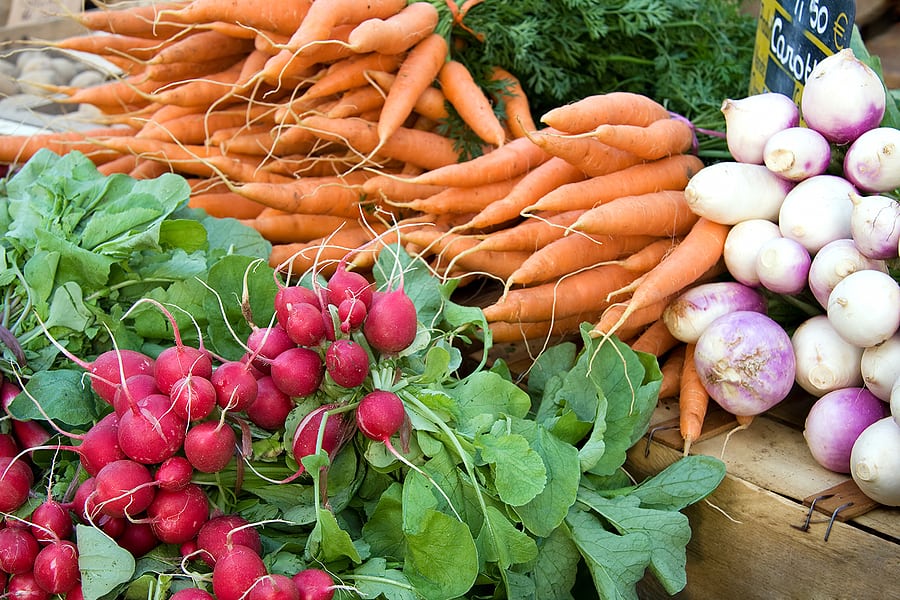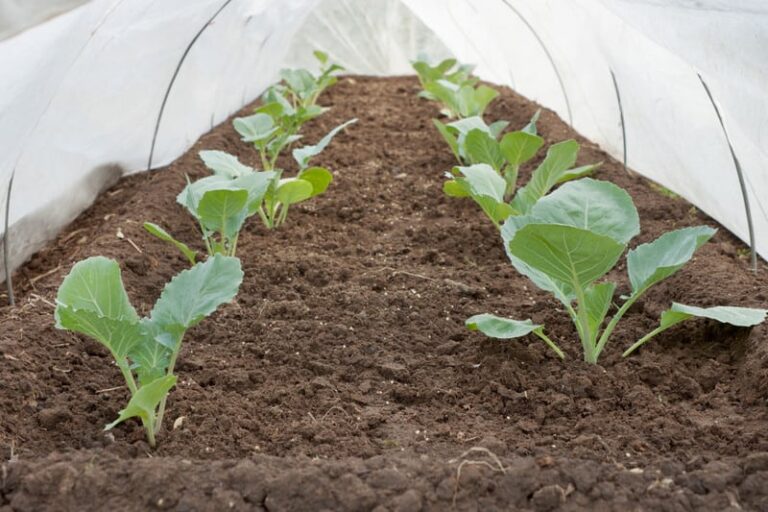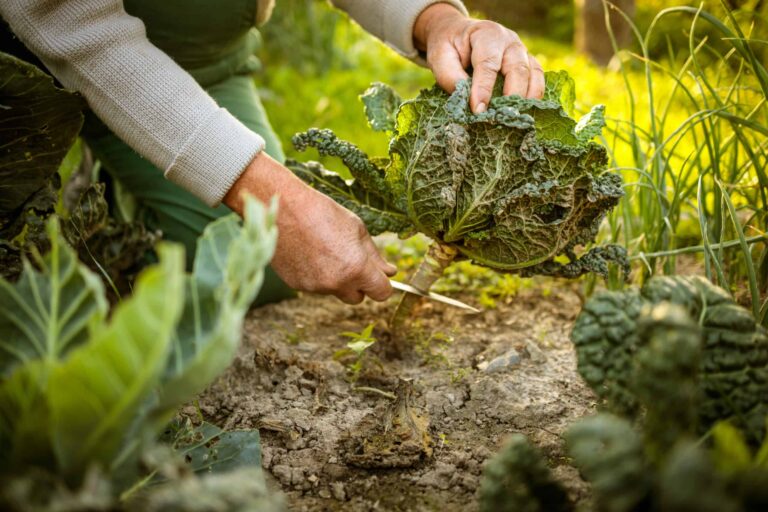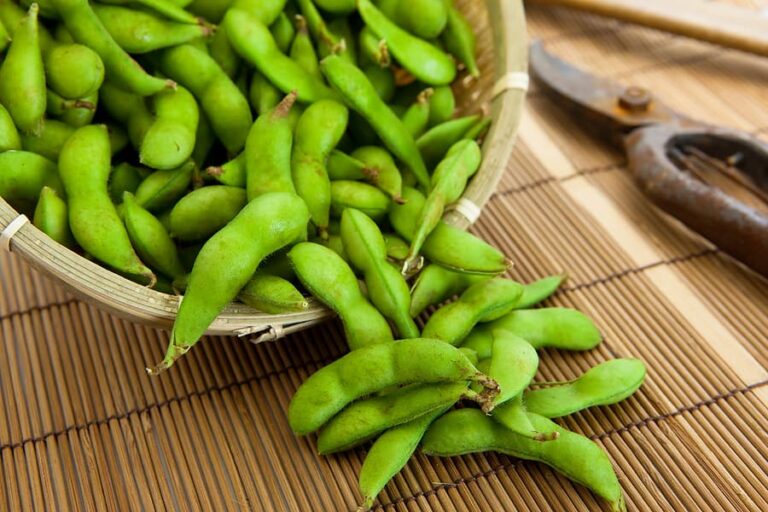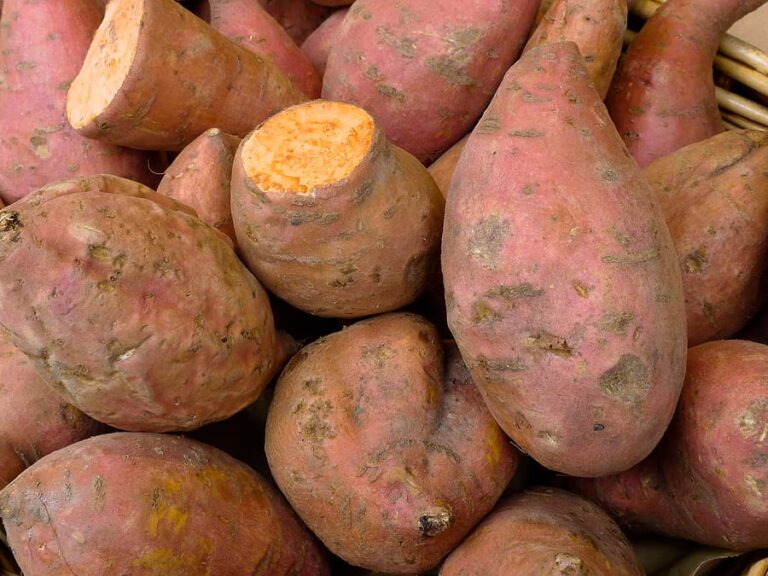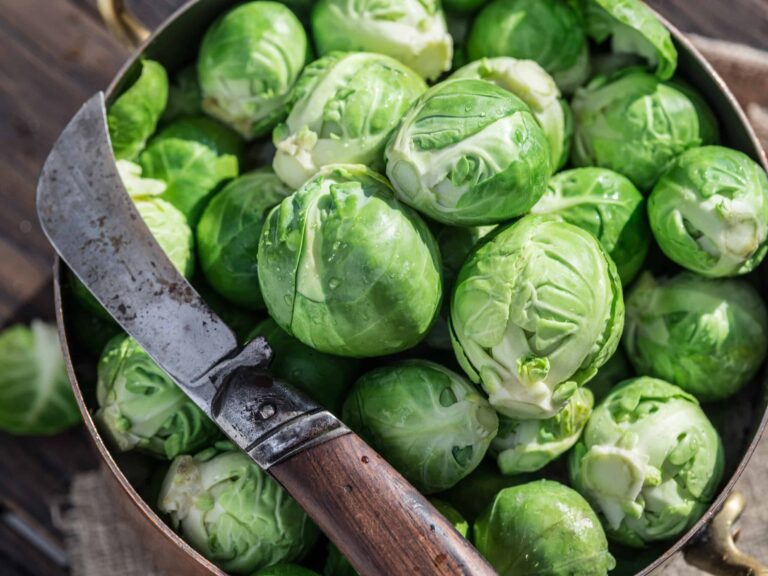Vegetables for Fall Harvest
Leafy greens, root vegetables, and members of the cabbage family are good fall harvest crops. These crops can be planted in mid- to late-summer for fall harvest.
Fall harvest crops are generally cool-weather crops, the same ones commonly planted in late winter or early spring for late spring or early summer harvest. Where autumn weather tends to be warm, some fast-maturing warm-weather crops such as snap beans, summer squash, and even quick-maturing tomatoes also can be planted in late summer for fall harvest.
Visit the Winter Garden and Season Extension Learning Hub
Good Products for Season Extension at Amazon:
- Walk-In Greenhouse Tunnel 15x7x7
- Row Cover for Freeze Protection 10×30
- Plant Cover Freeze Protection with Hoops
Cool-weather crops sown in summer for fall harvest often perform better than when planted in spring. In mid-to-late summer, garden soil is already warm–not warming as in spring–and seeds germinate more readily. As well, transplants get a faster start in the warm season than in the colder part of the year. Cool-weather crops prefer to mature in cool weather; cool-weather crops planted in spring often come to maturity as the weather is warming, not cooling.
Cooling and cold weather enhances the flavor of many crops coming to harvest in autumn as plant metabolisms change with cooler temperatures. Sugars accumulate in plant tissues of cool-weather crops as temperatures decline and crops become sweeter flavored. Leafy crops such as lettuce are sweeter tasting in cool weather. Brussels sprouts, kale, and parsnips are noticeably more flavorful when exposed to cooler temperatures and even frost.
Vegetables to plant for fall harvest
Leaf lettuce, spinach, mustard, Oriental greens, arugula, cress, sorrel, and kale make good fall crops. Beets, carrots, radishes, and turnips are also good fall harvest crops. All of these crops can be direct sown in the garden in mid-to-late summer.
Summer cabbage, cauliflower, broccoli, Brussels sprouts, Florence fennel, endive, escarole, and collard greens are crops for fall harvest that are best started indoors and later transplanted out into the garden. Start these crops indoors in early summer for mid to late-summer transplanting into the garden. (These crops can also be purchased as starts from a local nursery.)
Fall harvest vegetable varieties
Choose crop varieties with shorter days to harvest; some cabbage takes 90 days to harvest; other varieties are ready sooner. Choose varieties that are ready sooner–before the first freeze.
Leafy cool-weather crops such as lettuce will need protection if an early fall frost comes. Many fall harvest crops, however, can be left in the garden into winter, lifted just when you need them for cooking; these include most of the root crops and some of the cabbage family crops.
Fall harvest vegetable crops are long in old-fashioned, open-pollinated–meaning you can save the seeds to grow next year–varieties that have been tested in fall and winter gardens for generations. Here is a list of fall harvest vegetable varieties that should be easy to get from seed companies or neighbors:
Arugula
- ‘Rocket’ (‘Sylvetta’): 45 days from seed; pungent, short tasty leaves; wild arugula, also called ‘Wild Rocket’.
- See How to Grow Arugula.
Beets
- ‘Detroit Dark Red’: 55-60 days from seed; 3-inch blood red globes with red interior for table and canning; sweet and tender with tasty green tops; introduced in 1892.
- ‘Early Wonder’ (‘Greentop’): 50-60 days from seed; semi-globe, bright red with light zoning; smooth-skinned 3-inch-in-diameter roots with flavorful green tops; introduced in 1911.
- ‘Ruby Queen’: 55-60 days from seed; dark blood red round roots; smooth skin and fine, buttery texture, sweet for eating fresh and canning; All-American Selection winner in 1957.
- See How to Grow Beets.
Broccoli
- ‘Calabreze Green Sprouting’: 60-90 days from transplanting; dark green plant, 24 to 30 inches tall, with small deep blue-green central head; once the central head is harvested many side shoots produce for several months; came to America with Italian immigrants in 1880s.
- ‘Purple Sprouting’: 60 days from transplanting (120 days or more from seed); purple-green leaves and deep purple flower buds, very sweet tasting and turns green when cooked; frost-hardy to 10°F, start in fall for spring harvest; dates from before 1835.
- ‘Romanesco’: 75 to 110 days from transplanting; cauliflower-like pale green with spiraling 4 to 5-inch buds that come to a point; good texture and prized flavor for salads and dips; from Italy, grown since the sixteenth century.
- See How to Grow Broccoli.
Cabbage
- ‘Danish Ballhead’: 85 to 110 days from transplanting; round, blue-green heads, 5 to 7 pounds, firm, solid, tender mild flavor; good for storage; does well in cool and short-season regions; introduced in 1887.
- ‘Early Jersey Wakefield’: 85 to 110 days from transplanting; small, compact, green pointed heads, tinged with red, with delicious flavor; 2 to 4 pounds; frost resistant; introduced in 18840s.
- See How to Grow Cabbage.
Carrots
- ‘Long Orange Improved’: 85 days from seed; long, tapered to 12 inches (harvest before maturity), deep-orange roots; very good flavor and long keeping; introduced by the Dutch in 1620.
- ‘Scarlet Nantes’ (‘Nantes Half Long’): 70 days from seed; bright orange cylindrical root to 7 inches long with fine texture and sweet flavor; good storing carrot; introduced in 1870.
- See How to Grow Carrots.
Chinese Cabbage
- ‘Michihli’: 70 days from sowing; tall, cylindrical, romaine-type head with pale green leaves to 16 inches long and 4 to 6 inches across; crisp and tender, flavorful; use for pickling and stir-fry; introduced in the 1870s.
- See How to Grow Chinese Cabbage.
Collards
- ‘Georgia Blue Stem’: 60 to 65 days from seed; tall, blue-green leaves with open, cabbage-like heads; mild, tender flavor improves with frost; harvest all winter, new leaves form after each picking; introduced before 1880.
- ‘Vates’ (‘Blue Stem’): 75 days from seed; large, broad, crumpled blue-green leaves with mild cabbage-like flavor; frost-resistant; developed in Virginia.
- See How to Grow Collards.
Corn Salad
- ‘Verte de Cambrai’ (‘Green Cambrai’): 50 to 60 days from seed; dark-green oval leaves with fine texture and mild flavor when leaves are 4 to 6 inches long; very cold tolerant; sow in fall and overwinter–very cold tolerant; serve like lettuce or young as “baby mâche.”
- See How to Grow Corn Salad.
Endive-Escarole
- ‘Full Heart Batavian Escarole’: 85 to 90 days from seed; broad, round head 5 to 6 inches across; curled yellowish-green leaves and white blanched heart with buttery flavor; use in salads; frost tolerant; All-American Selection winner in 1934; originally from Holland.
- ‘Salad King Endive’: 100 days from seed; large heads of ribbed white leaves to 32 inches tall; tie outer leaves to blanch heart; early frost-tolerant.
- See How to Grow Endive and Escarole.
Kale
- ‘Lacinato’ (‘Black Cabbage’): 100 days from seed; open head, dark-green serrated leaves 2 to 3 inches wide, 10 inches long; winter hardy, freezing temperatures bring out its full flavor; a cross between sweet cabbage and kale; from Tuscany.
- ‘Vates’ (‘Dwarf Blue-Curled Scotch’): 55 to 65 days from seed; dwarf, blue-green finely curled leaves; 12 to 15 inches tall and 20 to 35 inches across; flavor improves with frost.
- See How to Grow Kale.
Lettuce
- ‘Black-Seeded Simpson’: 40 to 55 days from seed; loose leaf, broad light green, crinkly leaves; crisp, mild flavor; introduced before 1850.
- ‘Merveille des Quatres Saisons’ (‘Marvel of Four Seasons’): 55 to 70 days from seed; red bibb lettuce turns bright burgundy with cold; pale, creamy yellow hearts; crisp, tender flavor; French heirloom.
- ‘Red Sails’: 45 to 50 days from seed; compact, maroon-red leaves that deepen color with maturity; mild flavor; All America Selection winter in 1985.
- ‘Red Salad Bowl’: 45 days from seed; loose, frilly, rosette of wine-red deeply-lobed leaves; mild flavor; cut-and-come-again.
- ‘Salad Bowl’: 40 to 65 days from seed; loose, frilly rosette of medium-green deeply notched leaves; cut-and-come again; old-time variety.
- ‘Winter Density’: 55 to 60 days from seed; upright, compact heads; cool-weather favorites.
- See How to Grow Lettuce.
Mustard
- ‘Mizuna’: 40 to 65 days from seed; narrow, deeply cut leaves on white stalks; mild flavor; use for salads and stir-fry.
- ‘Tendergreen’ (‘Komatsuna’): 21 to 50 days from seed; flat, oblong, dark glossy green leaves with pale midribs to 10 inches tall; plant spreads 16 to 20 inches across; mildly pungent flavor between mustard and spinach.
- See How to Grow Mustard.
Radicchio
- ‘Red Verona’: 85 to 100 days from seed; bright red, round head with heart-shaped leaves; classic bitter flavor.
- See How to Grow Radicchio.
Radishes
- ‘Cherry Belle’: 24 days from seed; smooth, round root to ¾ inch in diameter; cherry red skin, white flesh; holds crispness; All-America Selection winner 1949.
- ‘Early Scarlet Globe’: 20 to 28 days from seed; globe-shaped, bright red skin with white flesh; delicate flavor; harvest at 1 inch for best flavor.
- ‘Sparkler White Tip’: 24 days from seed; globe-shaped, bi-colored bright red upper and white tip lower root; sweet, white flesh; lift when 1 inch across; holds its crispness.
- ‘Taokinashi’ (‘All Seasons’): 70 to 85 days from seed; Japanese daikon, 12 to 15 inches long; white, fine-textured flesh, crisp, mildly pungent flavor; can begin to harvest at 30 days.
- ‘Winter Icicle’ (‘White Icicle’, ‘Lady Finger’): 30 days from seed; white, carrot-shaped roots, 4 to 5 inches long; tender, mild flavor; harvest small to large; introduced before 1897.
- See How to Grow Radishes.
Spinach
- ‘Giant Nobel’: 40 to 55 days from seed; large, smooth green leaves with rounded tip; tender for fresh eating in salads when young; leaves thicken for steaming; excellent flavor; introduced in 1926.
- ‘Giant Winter’ (‘Gigante d’Inverno’): 45 to 50 days from seed; large, broad, semi-savoy, dark green leaves; tender and flavorful; cold hardy; Italian heirloom.
- See How to Grow Spinach.
Turnips
- ‘Amber Globe’ (‘Yellow Globe’): 60 to 65 days from seed; fine-textured, pale yellow flesh with sweet flavor; round to 6 inches across; hardy, keeping until spring; from before 1840.
- ‘Purple Top White Globe’: 45 to 65 days from seed; round white root below with reddish-purple top above ground; fine-textured white flesh, sweet, mild flavor; from before 1880.
- ‘White Egg’: 45 to 50 days from seed; medium-large, egg-shaped root with green crown and fine-grained, white flesh; from before 1880.
- See How to Grow Turnips.
Planting time for fall harvest
To calculate the planting dates for fall harvest crops, determine the first average frost date in your area; count back the number of days to maturity for each crop you plan to sow or transplant; add an extra week or two to the maturity time allowing for cooler temperatures and shorter days which slow plant growth. For example, sow broccoli three months before the first expected hard fall frost.
In the Northern Hemisphere, gardeners in Zone 5 and North can plant cool-weather crops for fall harvest in early July, zone 6 in late July, and Zone 7 in August. In zone 8 and south, cool-weather crops for a fall harvest can be planted in mid-to late-August and September.
An added advantage to mid to late-summer planting is the decline in weed growth and a decline in insect pest populations with cooling temperatures.
Planting for fall harvest
Direct sow seeds in summer in the cooler part of the day when water will not quickly evaporate. Seeds and transplants should be watered thoroughly after planting; seedlings should be protected from the harsh summer sun by shade cloth until average daytime temperatures begin to cool.
Seedlings started indoors should be gradually exposed to outdoor conditions–hardened off–just as seedlings are hardened off in spring. Harden-off vegetable starts out for a few hours each day, protected by shade until they become accustomed to outdoor conditions in a week or so.
Plant crops for fall harvest in blocks instead of rows. Crops planted in blocks are easier to keep watered and as plants mature their leaves will shade the soil and slow evaporation.
When to harvest the fall vegetables
Keep a calendar or notebook with planting dates and expected harvest dates to ensure you harvest your crops at their peak.
When the first frost is expected, be prepared to lift crops from the garden before they are damaged or place frost protection–such as frost blankets or plastic tunnels–over crops before a freeze occurs.
Carrots, leeks, parsnips, and turnips can be left in the late autumn and winter garden until needed; these crops should be protected by a one- to two-foot layer of mulch when freezing weather arrives. These crops should be harvested before the soil freezes solid.
Related articles:
How to Plant a Fall Vegetable Garden
Garden Planning Books at Amazon:

